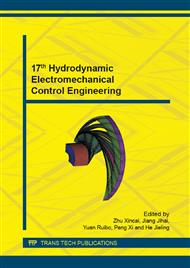[1]
Q. X. Hu, J. P. Bai, J. Ruan, Investigation of Cavitation Phenomena in the Valve Port of 2D High Frequency Valve Based on FLUENT, MACHINE TOOL & HYDRAULICS, 2012(2), Vol. 40, No. 3: 40~44.
Google Scholar
[2]
D. R. Zeng, B. Xu, Y. J. Liu, Anti-cavitation Analysis of Separate Meter In and Separate Meter Out Control System, MACHINE TOOL & HYDRAULICS, 2010(10), Vol. 38, No. 19: 1~3.
DOI: 10.1109/aim.2009.5230009
Google Scholar
[3]
H. Gao, X. Fu, H. Y. Yang, Tet suhiro T sukiji, Numerical Simulation and Visualization Study of Cavitating Flow in Hydraulic Ball Valve, Transactions of the Chinese Society for Agriculture Machinery, 2003(5), Vol. 34, No. 3 : 45-48.
Google Scholar
[4]
L. Wang, J. S. Chang. Computational Theory of Cavitating Flows with Consideration of Influence of Water Quality, Transactions of the Chinese Society for Agriculture Machinery, 2010(3), Vol. 41, No. 3: 62-66.
Google Scholar
[5]
H. M. Sun, F. X. Jing, Study on the Influence of Cavitation in Infusion Pipeline Elbow Structural Optimization, MACHINE TOOL & HYDRAULICS, Vol. 41 No. 9: 77-82.
Google Scholar
[6]
D. D. Joseph, Cavitation and the state of stress in a flowing liquid, Journal of Fluid Mechanics, 1998, Vol. 366: 367~378.
DOI: 10.1017/s0022112098001530
Google Scholar
[7]
D. D. Joseph, Cavitation in a flowing liquid, Physical Review. E, 1995, Vol. 51, No. 3: 1649-1650.
Google Scholar
[8]
S. Zhou, Research into Dynamic Performance and Digital Valve for Hydraulic Free Piston Engine, Hangzhou: Phd. Thesis of Zhejiang University, 2006. 7.
Google Scholar
[9]
K. Horinouchi, T. Yonekawa, S. Ito, et al, Numerical study of flow cavitation, SAE Transactions, 1990, 99(6): 1133~1140.
Google Scholar
[10]
T. Kuhl, M. Ruths, Y.L. Chen, J. Israelachvili, Direct Visualization of Cavitation and Damage in Ultrathin Liquid Films, The Journal of Heart Valve Disease, 1994, 3, S1 17-27.
Google Scholar
[11]
A.K. Singhal, M. M. Athavale, H. Y. Li, J. Yu, Mathematical basis and validation of the full cavitation model, Journal of Fluids Engineering, 2002, Vol. 124, No. 3: 617-624.
DOI: 10.1115/1.1486223
Google Scholar
[12]
V.H. Arakeri, A. Acosta. Viscous Effects on the Inception of Cavitation on Axisymmetric Bodies, Journal of Fluids Engineering, 1995(4): 519-523.
DOI: 10.1115/1.3447065
Google Scholar
[13]
R. S. Zhu, Q. Fu, W. B. Li, Numerical Simulation of 3D Two-phase Cavitation Flow in Impeller of the Low Specific Speed Centrifugal Pump, Transactions of the Chinese Society for Agriculture Machinery, 2006(5), Vol. 37, No. 5: 75-79.
Google Scholar
[14]
M. G. Yang, K. Ji, Z. Li, Numerical Calculation of Cavitating Flow in Impeller of Axial flow Pump, Transactions of the Chinese Society for Agriculture Machinery, 2010(9), Vol. 41: 10-14.
Google Scholar


